#sérapéum
Photo
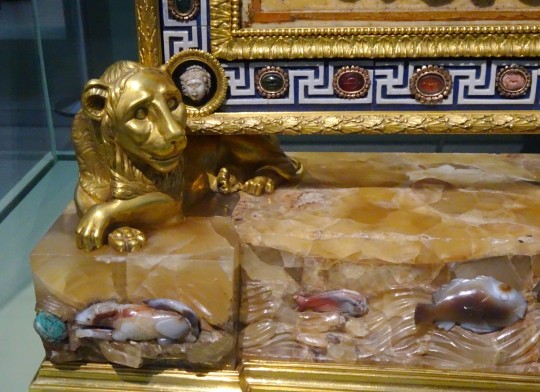





Au Louvre-Lens, il y avait une expo fort intéressante : “Champollion - La Voie des Hiéroglyphes”, sur l’homme, son époque, l’image de l’Egypte en Europe avant l’Egyptologie....
- à part le dernier : le camée Carpegna du Triomphe de Bacchus - 50 apr. J-C. ; monté par Luigi Valandier, 1780
- le dernier : lion du Sérapéum - Saqqara, temple de Nectanébo, Basse époque, 370 av. J-C.
#louvre-lens#égypte ancienne#égypte#champollion#archéologie#expo#la voie des hiéroglyphes#camée#camée carpegna#carpegna#bacchus#lion#sérapéum#luigi valandier#saqqara#nectanébo#basse époque#temple de nectanébo
20 notes
·
View notes
Text










The legendary burial that challenged
reason, logic, the laws of physics
and imagination.
It is the burial of the Serapeum in
the Saqqara area in Giza.
Underground burial at the bottom of
the mountain carved into the rocks.
It is long tunnels and corridors with
a length of about 300 metres,
very strange, beauty and splendor.
This burial was built to be a burial place
for the Apis calf.
This burial consists of a large hall
and a small hall.
This burial was discovered by the French scientist Mariette in 1848
This burial contains 24 sarcophagus
of very strong stones and rocks
such as granite, basalt and quartz
that come from Aswan quarries
from hundreds of kilometers away.
The first question:
How did they transport these rocks
from such long distances?
second question:
How was each sarcophagus made of
only one piece, weighing 70 tons,
and the lid of the coffin weighing 30 tons,
with a total weight of 100 tons?
How did they make it out of just one piece?
The third question:
How did they move those sarcophagus
into the burial through a door that is 3.2 meters wide?
the fourth question:
How did they get these sarcophagus
into these corridors?
Note that one coffin in order to move
only needs at least 500 strong men.
The fifth question:
How were they able with primitive
machines to sculpt the sarcophagus
from the inside so smooth that we found inside at an angle of 90 degrees with
very high accuracy.
Sixth question:
How did they dig these passages in
this way with a technique that resembles
the giant machines of today, such as
tunnel boring machines.
Seventh question:
How this was dug into the bottom of the mountain and rocks without lighting
or electricity.
Was the digging done by the light
of the flames?
Didn't the oxygen burn underground
and everyone die?
How did this happen?
The ancient Egyptian civilization is characterized by secrets, mysteries and surprises.
I can only say that the ancient Egyptians
had techniques and sciences that we
have not reached until today.
The burial of the Serapeum is considered
an underground miracle at the foot
of the mountain.
References:
- Auguste Mariette, Le Sérapéum de Memphis, Paris
#pharaonices
1 note
·
View note
Text
The Louvre and Eiffel Tower
28/04/2018: An early rise today for at least one person while the rest took it easy. The purpose was to take a walk through Jardin des Tuileries while the crowds weren't around. It was well worth the effort to be able to move around with plenty of room. After the walk, it was briefly back to the room and out again along Rue Saint-Honoré for croissants and pastries. Returning for breakfast we were then all on the move to Paris City Vision, also known as Get Your Guide to collect the Skip the Line tickets to the Louvre.

Allée Centrale, Jardin des Tuileries
We were in the queue at around nine fifteen, waiting to go through the Pyramid entrance security and down to Napoléon Hall, directly beneath the large glass pyramid. Today Shane made the choice of sticking with the girls and Tom and Beau heading off on a brother adventure. This was a wise move as the girls were always left behind as Cecilia wasn’t use to keeping up with the pace set by Shane and therefore the girls walked slower than the boys and were always left far behind. Sadly, we were to discover the reason for Cecilia’s struggle to keep up a few months after returning to Australia. Anyway, this separation between the men and women folk were making the girls feel like it was an “us and them” holiday when out exploring. So good boy Shane for keeping with the women today. We immediately grabbed a few maps and headed to the Sully Wing, via the ticket box and more security, where the some of the original fortress still stands. Last time it was closed for a reno. Also, the last time we were here, we were guided by Violetta, a masters student in French art and since that was what she was familiar with, that’s what we looked at. By the time we were finished the tour and were able to wander around at will, we were knackered. This time we were on a mission to see whatever else was around, but in particular, the Egyptian stuff.

The Foyer under the Glass Pyramid. Leading to all wings
First impressions were great. As we entered the basement of the Sully Wing, we were drawn to the start of the Pavillon de d'Horloge devoted to the history of the museum and its collections including the original fortress of which plenty still remains today.

Relationship of the original fortress within the Louvre
The path led around the base of what remained of the fortress and included a walkway so that we could walk within the original moat.
Prior to his departure on crusade in 1190, Philip II (King Philippe Auguste), son of Louis VII, erected a fortified enclosure to protect Paris against the threat of invaders while he was away. Ordering the construction of a great wall around the city, he reinforced it at the junction with the Seine by building a defensive fortress. Square in plan with corner towers and an imposing central keep. The Seine fed a moat that encompassed the entire structure with another moat surrounding the keep. Two gates, flanked by towers, were built within the wall, one facing south towards the Seine and the other facing east, leading to the city. As Paris spread west, the castle lost its defensive effectiveness and was later transformed into a luxurious royal residence by King Charles V.
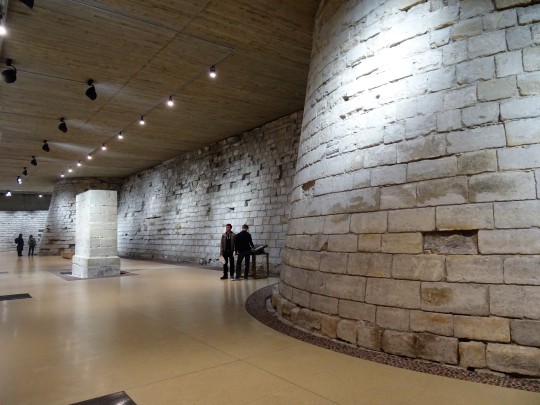
The outer wall of the fortress (and probably the outer moat)

The inner moat and the keep
The path skirted the outer moat and to the far side of the ruins, past the Crypt of the Sphinx and to a long staircase that climbed to the floor above. Halfway up we had a choice, left or right. We chose the right and ended up in the Greek, Etruscan and Roman Antiquities Rooms, which were shared by the Sully and Denon Wings and were welcomed by Athena, a three metre high antique replica of the original bronze from around 430BC.

Great Sphinx of Tanis. "Found" a couple of hundred years ago in the ruins of the Temple of Amun at Tanis (the capital of Egypt during the 21st and 22nd dynasties

Hello! (La Pallas de Velletri)
With Athena behind us, we entered a large room which was full of artefacts from the Greek, or Roman copies of long lost Greek bronzes going back several hundred centuries BC. Bigger than life (they're gods so they should be) statues of Ares, Aphrodites, Zeus, Hermes and such were scattered throughout with smaller, mantle size pieces around the peripheral and reliefs and friezes on the walls.

Aphrodite ("Venus Genitrix")
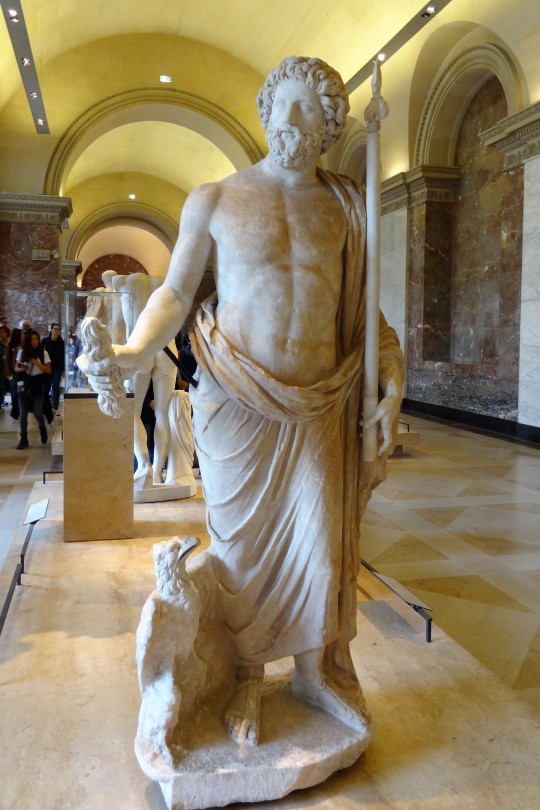
Zeus, dieu des cieux et maître de l’Olympe
The entire display covered the whole Mediterranean basin from the sixth century AD back to Neolithic times. At the end of the Greek section Venus de Milo, demanding her own room ferried us through to the Etruscan and Roman sections.
Doing an about face, we retraced our steps to the central stairs, descended to the landing, back up to the Egyptian Antiquities section and further to the Near Eastern area in the Richelieu Wing, dominated by Iran and Mesopotamia.
Small alcoves were lined with small figurines of Egyptian history. The larger areas were divided by displays of the same, thereby creating more small alcoves. Almost all of the displays were protected in glass. Interesting stuff, jewellery, trinkets, decorative objects, toys and what seemed like kitchen accessories.

Statue du dieu Horus, worshipped from at least the late prehistoric Egypt until the Ptolemaic Kingdom and Roman Egypt, he was one of the most significant ancient Egyptian deities

Partial sarcophagus lid
The row of sphinxes nearby was interesting, a half a dozen were impressive enough, but apparently several hundred of them lined the processional way to the Serapeum in Saqqara, which has long since gone. An 1850's tomb raider noticed these at various antique shops around town and put two and two together. It was apparent that some of the sphinxes came from the same place so he went out and found the place, thereby finding all of the sphinxes, buried in sand.
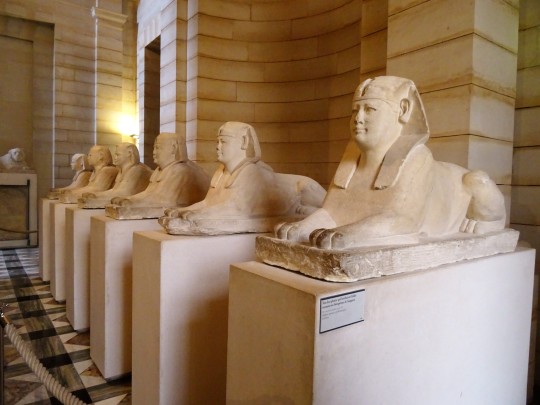
Six des sphinx qui bordaient l'allée menant au Sérapéum de Saqqara
We then came across the mummy sarcophagi, quite a few mainly protected by glass cabinets. Amongst them all was an actual mummy, a well preserved specimen of a male that lived during the Ptolemaic Period. After death and during the mummification process, he was covered in strips of linen and after receiving more attention to dry him out a bit, was covered in cartonnage which consisted of a mask covering his head, a wide collar over his chest, an apron across his legs and a casing over the feet.
This was one of the highlights of the day, probably for everyone as it was difficult to get close to him.

Momie recouverte de ses "cartonnages". Mummy covered with its "Cartonnages ". Embalming jars as well
As the Egyptian section finished, the Near Eastern Antiquities started. The Levant was an area located at the western extreme of the Mediterranean but not too far inland. It seemed to encompass modern day Syria, Jordan, down to what is now the Suez Canal and all between. The sarcophagus of Eshmunazar II, King of Sidon was carved around 500BC for a king whose demise was ahead of his time (he died when 14 years old and ruled the kingdom with his mother). Sidon was located in Phoenicia, now Lebanon and later expanded its horizons by being given lands by the Persian "Lord of Kings", Xerxes as reward by providing their naval fleet to the Persian forces.
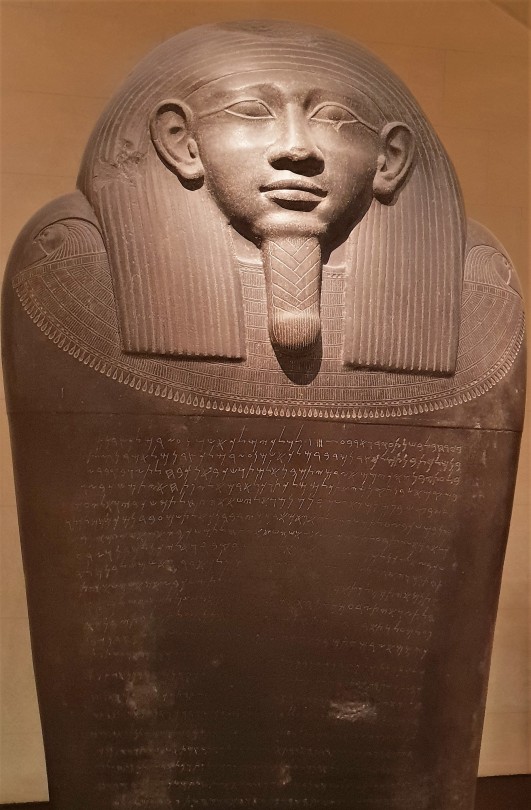
The epitaph across the chest and around the head describes a king who died young and curses on anyone who should trouble his rest among the Rephaïm, followed by a genealogy of the royal family, concluding with a final curse on those who would "raise my slab" and remove the sarcophagus.
The next section was Iran followed by Mesopotamia. There was some great stuff here, the highlights being some friezes from the Persian King Darius I back around 500BC. The first was of lions made of a glazed brick and came from Mesopotamia. They were displayed in his Susa palace and was a symbol of power, embodying the king of beasts. The next frieze was not so certain as to its origins. They were the Archers on Parade depicting two symmetrical lines of soldiers, bow and quiver around their shoulders, both hands holding their spears. Very impressive and quite colourful.
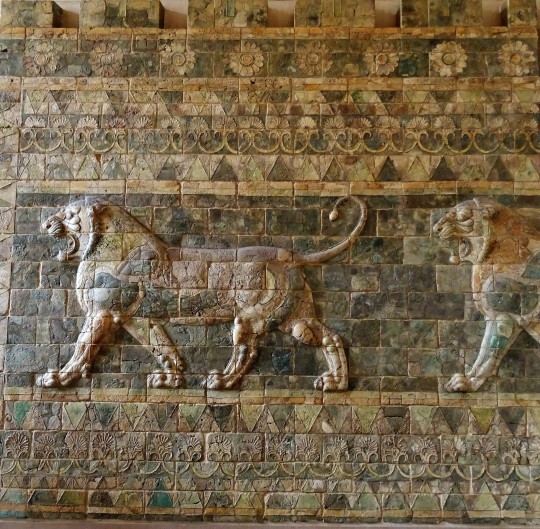
The Frieze of Lions from the first court of Darius I’s palace at Susa

Archers on Parade
Although there was other great stuff in this area, the other impressive artefact was the temple headstock and column (or the colossal capital), one of thirty six that once held up the roof components of the apadana at Susa. A couple of bulls kneeling back to back atop of Egyptian style palm fronds and double volutes with rosettes taken from the temple of Artemis at Ephesus. There wasn't too much in one piece when excavators excavated during the late nineteenth century which explained the colour difference (veined grey limestone brought to the plain of Susa from the Zagros Mountains) due to the capital being reconstructed from bits and pieces of the thirty six columns that originally existed.
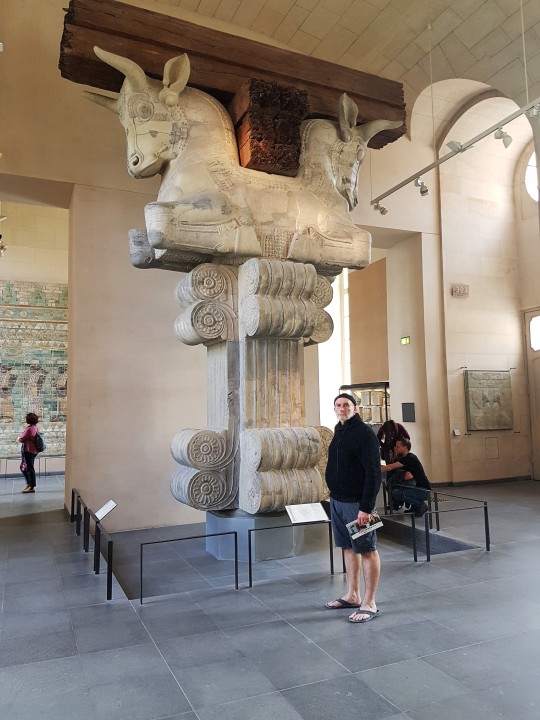
Chapiteau d'une colonne de la salle d'audiences (Apadana) du Palais de Darius Ier
The final part, after a break at the café overlooking Napoléon Hall, was back to the Denon Wing to finish off with a few more statues and some paintings, particularly looking forward to the pushing and shoving in front of the Mona Lisa. After ascending a rather grand staircase we found ourselves on the ground floor amongst the European sculptures before climbing one more floor to the paintings of France, Italy and Spain. One of the final acts of the morning, after wandering through the corridors of religious art was to enter Room 711 where the incredibly underwhelming Mona Lisa proudly hung.
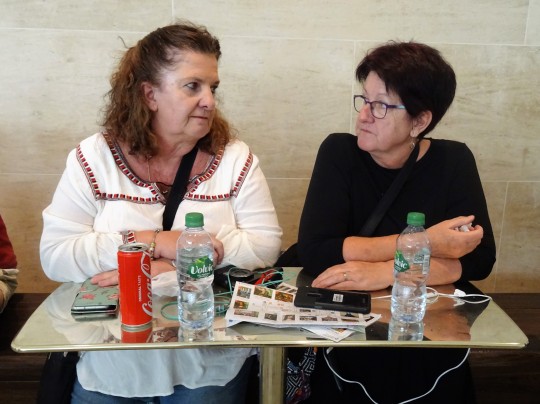
First break for the day.

Andrea di Bartolo dit Solario. La Crucifixion

There she is
That was it. Louvre over and lunch ahead, followed by the tower. Playing it safe, we headed back to where we knew, via the Carrousel du Louvre underground shopping centre, eventually reaching the surface at Arc de Triompe du Carrousel, watched a weirdo pigeon man walking around dropping wheat out of his pockets and braved the irksome Africans and gypsies trying to con us or flog us something. Once through the cordon of conmen we settled in at the Le Carrousel Bar and Brasserie for pizza and snails.

Cordon of conmen

Snails for lunch
After lunch we walked back through the gardens towards Place de la Concorde and further to Avenue Winston Churchill, across the road from the Grand Palais. From there we had a good look at our next destination, the Eiffel Tower. Shane and Jo had seen it before so were doing something different while Cec and the boys went to the top. We proceeded as one to the ticket place where they would meet up with their escort for the trip to the top, then separate for a while.

We Shall Never Surrender
Winston Churchill
Londres le 4 Juin 1940
Leaving Cec, Tom and Beau at the meeting place and agreeing to meet below at the tower ticket collection box later on, Jo and Shane headed along Rue de Grenelle a few streets away to Rue Cler for a Rick Steves audio tour starting with Café Rousillon.
Emmanuel Macron lived in an apartment in Rue Cler before becoming president. Even though he and his wife occasionally shopped in the street, business owners and residents were glad to see the back of them after he was voted in as president. From the vote until the inauguration, the lived in Rue Cler but then moved to Palais de l'élysée, the Presidential residence. During that period the extra security, movement restrictions and extra crowds caused the locals some angst until he left and calm was restored. Shop owners lost business due to street closures. It's okay now and they'll probably be welcomed back when he leaves politics.

Café Rousillon

At the Bar Prices
Taking Rick's advice and saving money by standing for cafés, we then moved across Rue de Grenelle to a neat and village like street, lined with open aired produce stands, made particularly inviting by excluding all but service vehicles beyond the intersection.
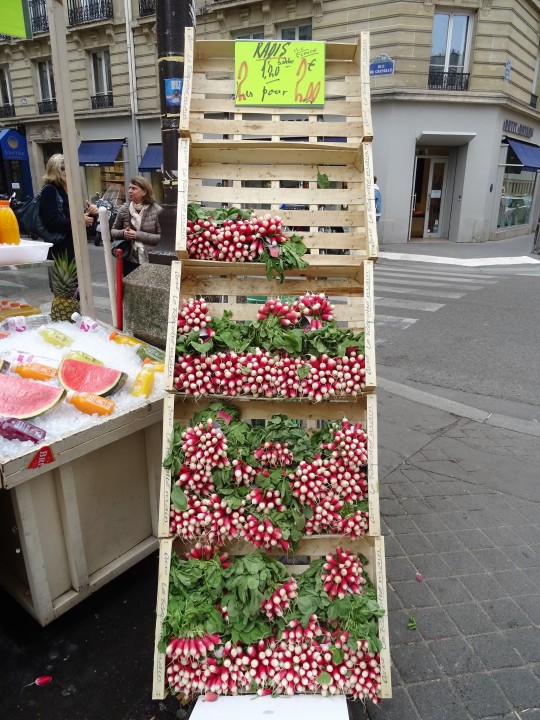
Bunches of radishes. The French have a real flair for produce display

Looking down Rue Cler from Café Rousillion
The street had everything. Apparently, many Parisiennes shop for food daily in street markets just like this as not only are they after fresh food, but their apartments are small and so are their fridges. To shop daily may not only be a preference but a necessity.
Immediately on our left was the only supermarket to be seen, albeit typically small. A fruit stall on either side constricted the street but it soon opened up to specialty shops, hotels and banks, hidden behind closed doors and partially obscured by the fishmongers, cheese shops, bakers and butchers who opened their doors wide and spilled their produce onto the street.
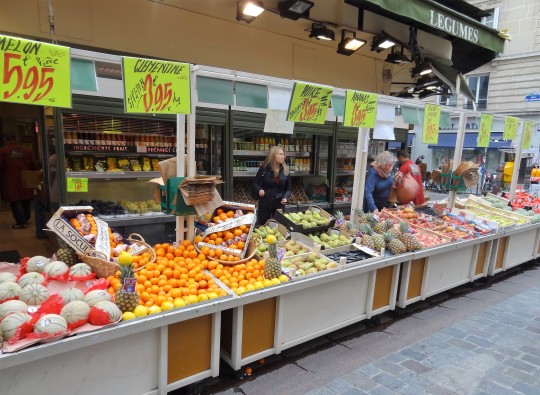
Top Halles
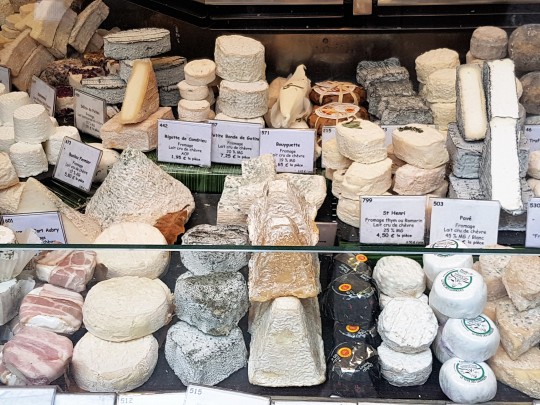
La Fromagerie
La Fromagerie has been in Rue Cler for generations, straight across the street was La Sablaise Poissonniere-Traiteur, supplying fresh seafood daily from the English Channel. There were more cafés, where if one desired could have a café and smoke while sitting on the footpath, facing the crowds, Traiteur Jeusselin which served precooked meal portions for people to buy on their way home from work if too busy to cook and Boucherie du Perche. People around the area didn't have a garden per se, but flower boxes hanging from the window sill. They still had an appetite for flowers as the florist was pretty popular.
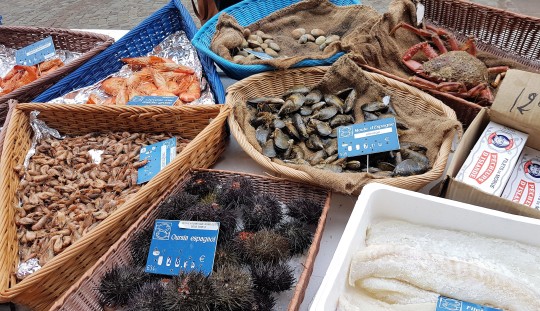
La Sablaise Poissonniere-Traiteur

Boucherie du Perche

Cler Fleurs
This was an interesting experience but catering more for the top end of town given some of the prices.
Rue Cler came to an abrupt halt at its intersection with Avenue de la Motte-Piquet. Turning right we followed the avenue to the Cavalerie building on Place Joffre, standing at the top of Champ de Mars, a tree lined and grassed park which would lead us to the Eiffel Tower at the other end.
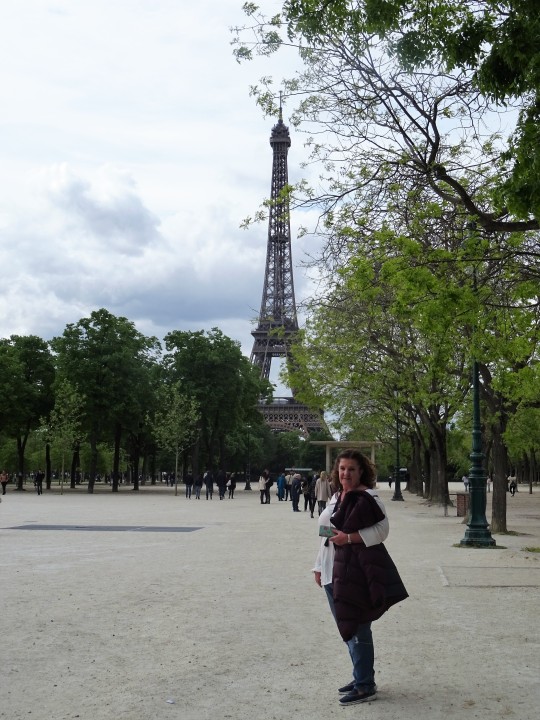
The tower at the end of Champ de Mars
Partially down the Champ de Mars we were lucky enough to experience something that made our day. Amongst the families and couples taking it easy around the place, there was a young couple quickly becoming the centre of attention. The young bloke had a couple of mates with him and duly went down on one knee and opened up a jewellery box with a ring in it. Whilst this was happening one of his mates was playing the violin and the other recording everything. We were a bit far away to hear but she must have said yes as those closer started to applaud. A touching moment to soon be over shadowed by the crowds ahead and the hordes of Africans trying to flog models of the tower.

Romance in Champ de Mars
While this was all happening, Cec, Beau and Thomas were enjoying the city from the top of the tower.

Looking over Paris
As Jo and Shane moved closer to the proposed meeting point below the tower, it was apparent that it would not go to plan. Considerable construction works were underway to construct a "terrorist proof" fence around the tower. The fence will be made of thick glass that will supposedly stop bullets and car bombers and cost several tens of millions of Euro.

Let the fence begin
With no communication and our meeting plan in tatter as there was no ticket box to meet as planned and there were 4 different entry/exit points, we had no idea where the crew would emerge from. Jo and Shane headed to the park besides the north rafter and waited. Jo wandered around panicking, Shane just sat, moving around, trying to find a seat without bird shit on it. There were plenty of vacant benches for a reason. Just as annoying were the Africans, they were everywhere trying to make a buck. There didn't seem to be much competition as they were all standing together in small groups selling the same thing, models of the tower. They did however, move pretty quickly when the gendarmes approached. Within not to long spent waiting, firstly Tom and Beau walked out the gate followed a short time later by Cecilia, bitchin about how the group dropping them off somehow and they had to fend for themselves. Anyway, it didn't matter now as we were all together again. When asked how did they enjoy their experience, Cecilia said she was too terrified, fearing that an attack on the tower was imminent, As like all major tourist spots, the area had armed troops patrolling the area and being a large city, sirens wailing through the streets was commonplace, we were use to this from previous travels but this was a new experience for Cecilia , thus fuelling her fear for expecting a disaster was pending. Beau has an extreme fear of hieghts but was proud of the fact he did manage to stand at the railings of the top level viewing deck, take in the vista, albeit feeling like he left his fingerprints embedded in the steel hand rail.
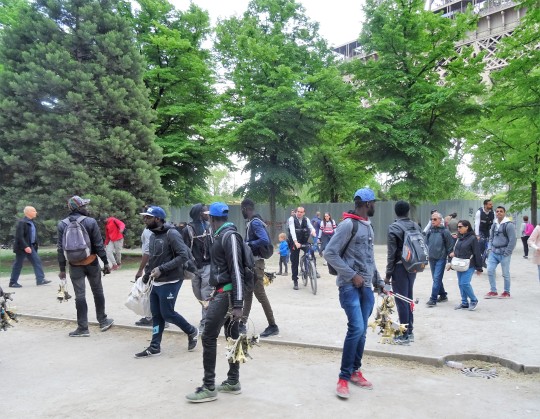
Gendarmes causing a stir
The trip back to the apartment was interrupted by a beer at Café Roussillon in the Le Cler district. While here, Beau made a very interesting observation, on visiting the toilet area of the bar. There was only one toilet that had a step up to it, the disabled toilet. What the Heck!! Time to head home. Women taxied; men walked. By then it was after seven, back at the apartment by eight.
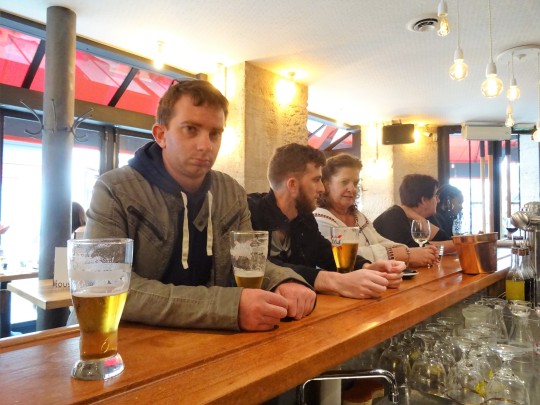
Back at Café Roussillon

Cosy lift

Twilight view from our apartment
Tomorrow, the Catacombes, for the boys, a special treat, for the girls with breakfast and Café Angilina, and then Notre Dame, Saint-Chappelle and the football.
1 note
·
View note
Photo

Saqqarah - Égypte
Situation géographique
Au sud du Caire s'étend le plateau de Saqqarah, au centre de la nécropole de Memphis qui s'étend sur près de vingt kilomètres. « L'ensemble situé à l'orée du désert - à la lisière du monde de la mort - témoigne d'une volonté (...) de défier le temps ».
Chronologie
Dès les premières dynasties les rois et les membres de l'aristocratie y font bâtir leur mastaba. La tombe la plus ancienne (numérotée 3357) remonte au règne de Hor-Aha, le deuxième souverain de la Ire dynastie. La première pyramide est édifiée par Imhotep, l'architecte de Djéser (IIIe dynastie) vers -2600. On s'accorde à dire qu'il s'agit là du premier édifice en pierre de l'Égypte. Cette vaste enceinte, enfermant des cours et répliques de temples de l'époque, nous laisse un témoignage pétrifié inestimable des sanctuaires des premiers temps.
Nécropole royale sous l'Ancien Empire, le site se développe autour des pyramides royales des Ve et VIe dynasties. De nombreux mastaba de cette époque nous sont parvenus contenant des reliefs d'une qualité parfaite décrivant la vie quotidienne de l'Égypte antique.
Au Moyen Empire, avec l'éloignement de Pharaon et de sa cour, d'abord à Thèbes puis dans le Fayoum, la nécropole fut quelque peu délaissée.
Sous le Nouvel Empire, avec le renouveau de la ville de Memphis pendant les XVIIIe et XIXe dynasties, les nobles et courtisans se font à nouveau inhumer à Saqqarah, dans des tombeaux surmontés par de véritables temples-chapelles funéraires.
L'un des plus célèbres est celui qu'Horemheb se fait construire avant même d'être couronné pharaon. Les reliefs de cette chapelle le représentent en général doté de l'uræus royal, indiquant ainsi son avenir hors du commun.
C'est aussi à Saqqarah que l'on trouve les tombes des taureaux sacrés Apis dont le culte est rendu à Memphis. Inauguré à la XVIIIe dynastie, le Sérapéum se développe surtout sous les ramessides. Le fils de Ramsès II, Khâemouaset, grand prêtre de Ptah, passé à la postérité par des légendes le qualifiant de grand magicien, laisse des stèles et inscriptions relatant la restauration des tombes d'Apis ainsi que l'inauguration de la grande catacombe qui ne cesse alors de s'agrandir pour accueillir les dépouilles momifiées des taureaux sacrés. Mort avant son père, Khâemouaset est inhumé dans le Sérapéum.
Puis à la Basse époque un sanctuaire édifié devient l'un des centres de pèlerinage des plus importants à la fin de l'histoire égyptienne sous les Ptolémées puis sous les empereurs romains. Une avenue bordée de sphinx mène au temple consacré à Apis (disparu aujourd'hui) auquel on accède par un dromos traversant un hémicycle à l'architecture hellénistique abritant des statues des principaux philosophes et penseurs de l'antiquité.
D'autres sanctuaires dédiés à Anubis et à Bastet sont édifiés à côté de catacombes enfermant dans des galeries interminables quantités de momies animales, témoins de la ferveur populaire pour les cultes d'animaux sacrés.
Les Européens et les Égyptiens qui continuent de fouiller le sol de Saqqarah découvrent de nombreux tombeaux jusqu'alors ignorés. Une fresque représentant l'équarrissage d'un bœuf est découverte dans la sépulture d'un noble de l'Ancien Empire. Au temps des pharaons, les égyptiens veulent croire en l'immortalité de la personne humaine. Pour cheminer dans l'au-delà, celle-ci doit retrouver les images quotidiennes de la vie et, notamment, des représentations de la nourriture.
0 notes
Photo

L’Egypte des Pharaons au @museelouvre Le déchiffrage des hiéroglyphes en 1822 par Champollion grâce à la pierre de rosette 1📷Cuiller en forme de jeune fille portant un vase 2📷Couvercle du sarcophage de Djedhor - IV siècle av.J.C_ Acquis en Egypte par Champollion. Sur le couvercle : l’âme du mort, un oiseau à tête humaine. 4📷Six des sphinx qui bordaient l’allée menant au Sérapéum de Saqqara IVe ou III e siècle av JC, début époque Ptolémaïque. Calcaire. 5📷Barque de procession de la déesse Anouket. Vers 1250 av. J-C (19e dynastie) trouvée à Eléphantine. Bois autrefois peint. 6📷Statue d’homme, sans doute Isi . À droite statue d’un couple, l’homme sans doute Isi et da femme. Calcaire peintTrouvés au pied de leur tombe. 7📷Statue du dieu Horus. Période intermédiaire, 1069-664, av. J_C. Bronze autrefois recouvert de matériaux précieux (enduit doré, feuilles de métal) #museedulouvre #louvremuseum #thegazeofaparisienne #thegaze #pharaons #egypteantique (à Musée du Louvre) https://www.instagram.com/p/CHrs-HVBr5T/?igshid=gc3i4fhiqru0
0 notes
Text
The legendary temple that challenged reason, logic, the laws of physics and imagination.
It is the Temple of the Serapeum in the Saqqara area in Giza.
Underground temple at the bottom of the mountain carved into the rocks.
It is long tunnels and corridors with a length of about 300 meters, very strange, beauty and splendor.
This temple was built to be a burial place for the Apis calf.
The calf is embalmed and becomes a mummy to be buried.
But when the temple was discovered, they did not find any mummy.
This temple consists of a large hall and a small hall.
This temple was discovered by the French scientist Mariette
year 1848
This temple contains 24 sarcophagi of very strong stones and rocks such as granite, basalt and quartz that come from Aswan quarries from hundreds of kilometers away.
The first question:
How did they transport these rocks from such long distances?
second question:
How was each coffin made of only one piece, weighing 70 tons, and the lid of the coffin weighing 30 tons, with a total weight of 100 tons?
How did they make it out of just one piece?
The third question:
How did they move those coffins into the temple through a door that is 3.2 meters wide?
the fourth question:
How did they get these coffins into these corridors?
Note that one coffin in order to move only needs at least 500 strong men.
The fifth question:
How were they able with primitive machines to sculpt the coffin from the inside so smooth that the scientist Christopher Dunn measures the coffins and finds them from the inside at an angle of 90 degrees with very high accuracy.
Sixth question:
How did they dig these passages in this way with a technique that resembles the giant machines of today, such as tunnel boring machines.
Seventh question:
Why was there not a single calf inside the coffins?
Or is this coffin made for something else that we don't know about yet?
Eighth question:
How this was dug into the bottom of the mountain and rocks without lighting or electricity.
Was the digging done by the light of the flames?
Didn't the oxygen burn underground and everyone die?
How did this happen?
The ancient Egyptian civilization is characterized by secrets, mysteries and surprises.
I can only say that the ancient Egyptians had techniques and sciences that we have not reached until today.
The Temple of the Serapeum is considered an underground miracle at the foot of the mountain.
References:
- Auguste Mariette, Le Sérapéum de Memphis, Paris
sources:
https://pharaonices.com/the-legendary-serapeum-temple.../





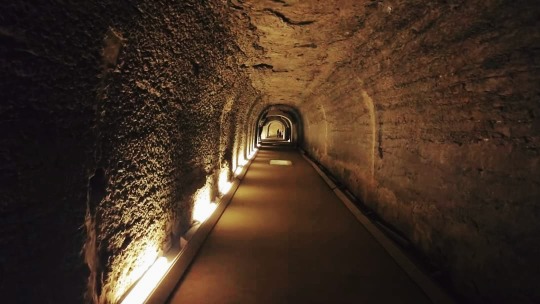




1 note
·
View note